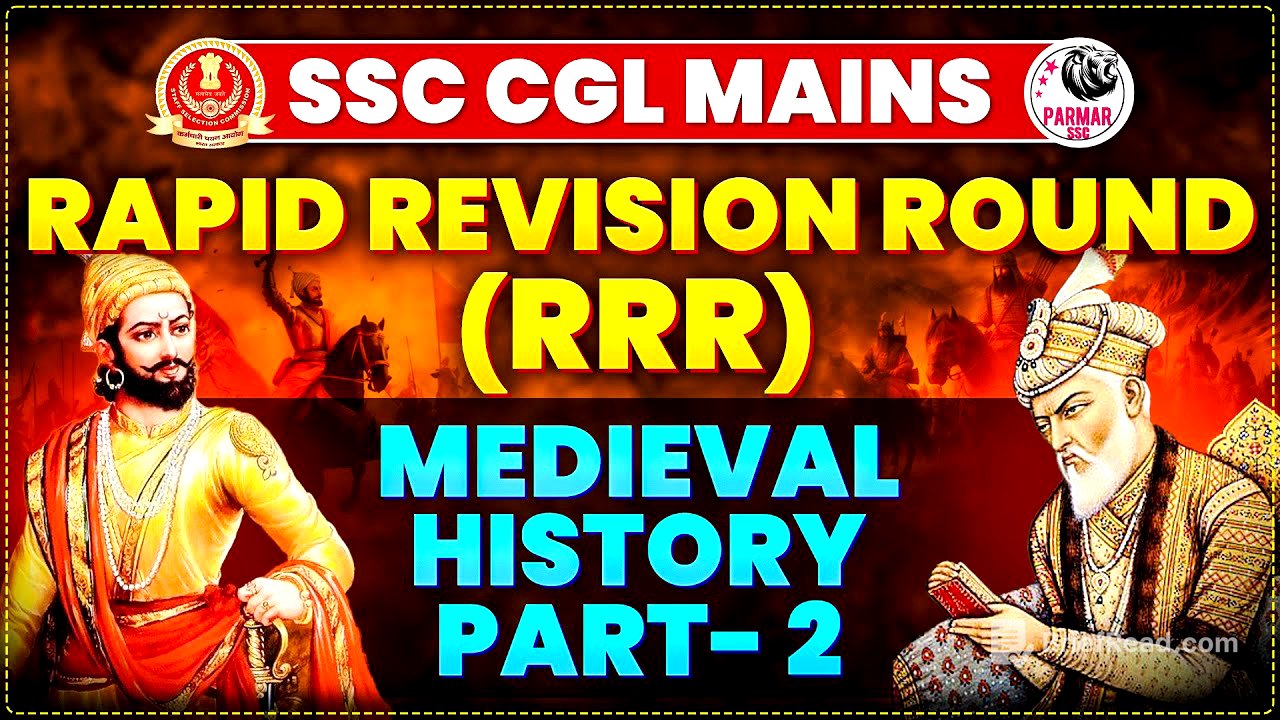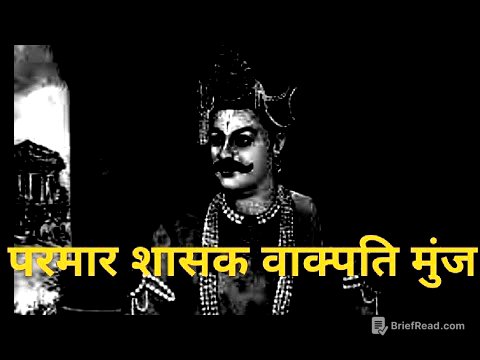TLDR;
Alright, so this lecture is all about the Vijayanagara Empire, the Bahamani Sultanate, and the Mughal Sultanate. We'll be looking at the dynasties, rulers, key events, and administrative systems of each. Key points include the establishment and fall of Vijayanagara, the split of the Bahamani kingdom, and the rise and initial rulers of the Mughal Empire.
- Vijayanagara Empire: dynasties, rulers, key events, and administrative systems
- Bahamani Sultanate: split of the kingdom
- Mughal Empire: rise and initial rulers
Vijayanagara Empire: Foundation and Rulers [0:08]
The Vijayanagara Empire and the Bahamani Sultanate were like, neighbours, with the Krishna River acting as the border. The Vijayanagara rulers were called Narapati, while the Bahamani rulers were known as Ashwapati. The empire, also known as the Karnataka Empire, had Hampi as its capital, named after their local goddess Pampa Devi. Founded in 1336 by Harihar and Bukka, the empire saw rule by four dynasties: Sangam, Sulwa, Tuluva, and Arai Vadu. During this time, travellers like Ibn Battuta, Niccolo di Conti, and Abdul Razzaq visited and wrote about the empire.
Tuluva Dynasty and Krishna Devaraya [2:50]
The Tuluva Dynasty, especially under Krishna Devaraya (KDR), saw a golden period from 1509 to 1529. KDR built structures like Vijay Mahal, Hazar Rama Temple, and Vitthal Swami Temple. He was also known as Yavana Raj Priya for restoring kingdoms and held titles like Andhra Bhoj. He wrote "Amukt Malida" in Telugu and "Jam Bhavati Kalyanam" in Sanskrit. Two travellers, Barbo Sea and Doming Peace, visited during his rule, and he had Ashta Digj in his court.
Decline of Vijayanagara and Administration [4:37]
The Battle of Talikota in 1565 led to the decline of the Vijayanagara Empire, with the Deccani Sultans destroying it. The Arai Vidu dynasty ruled a smaller part until 1930, with Vas Sriranga the Third as the last ruler. The empire's administration featured immortal heroes (military commanders) and the Iyengar system, a village committee with 12 members. Travellers like Niccolo de Conton, Abdul Razzaq, and Farnav Nanij visited during the reigns of Devrai I, Devrai II, and Achyut Devrai, respectively.
Vijayanagara Architecture and Bahamani Kingdom [6:20]
Vijayanagara's architecture was divided into the Sacred Center (temples) and the Royal Center (king and ministers). The Royal Centre featured the Mahanavmi Dibba. Key structures included the Kamalpur tank and Lotus Mahal. The Virupaksha Temple and Hazar Rama Temple were significant. The Bahamani Kingdom, founded by Alauddin Mahman Shah in 1347, had Gulbarga as its capital. Tajuddin Firoz Shah and Ahmed Shah Wali were notable rulers.
Bahamani Kingdom's Division and Delhi Sultanate [8:38]
Ahmed Shah Wali shifted the capital from Gulbarga to Vidar. Humayun Shah gave Mahmood Gawan the title Malik Taj Jur (Chief of Merchants). The Bahamani Kingdom eventually split into five smaller kingdoms: Bijapur, Ahmednagar, Golconda, Bidar, and Birar. In the Delhi Sultanate, the Lodi Dynasty was the last, with Ibrahim Lodi being defeated by Babar.
Babar's Conquests and Humayun's Reign [11:16]
Babar, who became the ruler of Fargana at 12, established himself in Kabul before attacking Ibrahim Lodi in 1526. He won the Battle of Panipat in 1526, the Battle of Khanwa in 1527, and the Battle of Chanderi in 1528. His original name was Zaheerul Mohammad Babar, and he wrote his autobiography, Tuzuk Babri, in Turkish. He built Aaram Bagh in Agra. Humayun, Babar's eldest son, used the Tulag Ma strategy in battles. He ruled from 1530 to 1540 but faced challenges.
Shershah Suri and Humayun's Return [13:24]
Humayun was defeated by Shershah Suri in the battles of Chausa (1539) and Kannauj (1540). Shershah Suri, whose original name was Farid Khan, built the GT Road and his mausoleum in Sasaram, Bihar. Humayun fled to Iran in 1540 and returned in 1555. He died shortly after due to an accident. Humayun's tomb in Delhi was built by his wife, Haji Begum, and his biography, Humayun Nama, was written by his sister, Gulbadan Begum.
Akbar's Early Reign and Conquests [16:28]
Akbar, born Jalaluddin Mohammed, ascended the throne in 1556. The Second Battle of Panipat was led by Bairam Khan, Akbar's guardian. Akbar constructed Buland Darwaza in Fatehpur Sikri after his victory in Gujarat. He shifted the capital to Fatehpur Sikri in 1571 due to Sheikh Salim Chisti's blessings. Later, he moved the capital to Lahore in 1585 and then to Agra in 1598.
Battle of Haldi Ghati and Akbar's Policies [18:28]
In 1576, Akbar fought the Battle of Haldi Ghati against Maharana Pratap of Mewar, with Maan Singh leading Akbar's forces. Akbar married Harka Bai (Jodhabai), the daughter of Bharmal of Amer. Akbar introduced the Deen Ilahi religion and implemented land reforms like the Jabti or Dahsala system, based on 10-year revenue assessment. The land was divided into four categories: Polaj, Pauti, Chach, and Barren.
Mansabdari System and Akbar's Court [21:59]
Akbar introduced the Mansabdari system, dividing ranks from 10 to 7000. Mansabdars were required to maintain a certain number of horsemen. Akbar built structures like Panch Mahal, Agra Fort, and Allahabad Fort. His court had Navaratans, and he opened a translation department to convert Sanskrit texts into Persian.
Akbar's Religious Interests and Tansen [23:38]
Akbar got the Ramayana translated into Persian as "Badni" and the Mahabharata as "Razmnama." He established Ibadat Khana for religious discourses. Tansen, originally Ram Tanu Pandey, was a musician in Akbar's court, known for his musical abilities.
Akbar Nama and Jahangir's Accession [25:33]
Abul Fazal wrote Akbar Nama, a three-volume biography of Akbar, with the third volume known as Aine Akbari, detailing Akbar's administration. After Akbar, Jahangir (Nuruddin Mohammad Salim) ascended the throne.
Jahangir's Reign and Shahjahan's Succession [26:13]
Jahangir created the Chain of Justice and married Meher Nisa (Noor Jahan). William Hawkins and Sir Thomas Roe visited during his reign, and he allowed the English to establish a trading port at Surat. He got the fifth Sikh Guru, Arjun Dev Ji, murdered. Jahangir wrote Tuj ke Jahangiri in Persian.
Shahjahan's Architecture and Aurangzeb's Conquests [28:45]
Shahjahan built Deewane Mango and Deewane Khaas. He defeated the Portuguese and Ahmednagar. Travellers like Bernier and Tove Nearer visited during his time. He constructed the Red Fort, Jama Masjid, and Taj Mahal. Aurangzeb defeated Dara Shako in the Battle of Dharmat and Sahugarh in 1658 and took the title of Alamgir.
Aurangzeb's Policies and Mughal Decline [30:06]
Aurangzeb got Guru Tegh Bahadur murdered for resisting the conversion of Kashmiri Pandits to Islam. He annexed Bijapur in 1686 and Golconda in 1687. He issued Fatwa-e-Alam Giri and reintroduced Jizya. Aurangzeb died in 1707 in Daulatabad (now Shambhaji Nagar) and was known as Zinda Peer. The Mughal Sultanate declined after him.
Later Mughals and End of the Empire [31:27]
Mohammad Shah Rangeela was a later Mughal ruler during whose reign Nadi Shah attacked and looted the Peacock Throne and Kohinoor Diamond. Bahadur Shah had the last rule. Bibi's tomb was built by Prince Azam Shah in memory of his mother, Dilra Banu Begum. This marked the end of the Mughal Empire.









